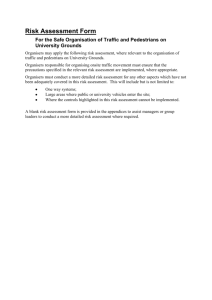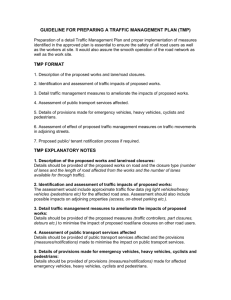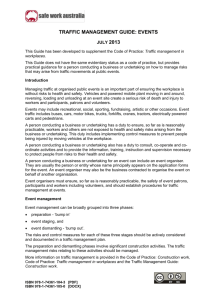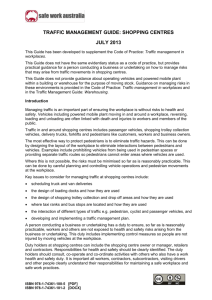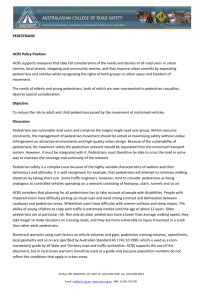Mathematical Modelling in Traffic Flows
advertisement
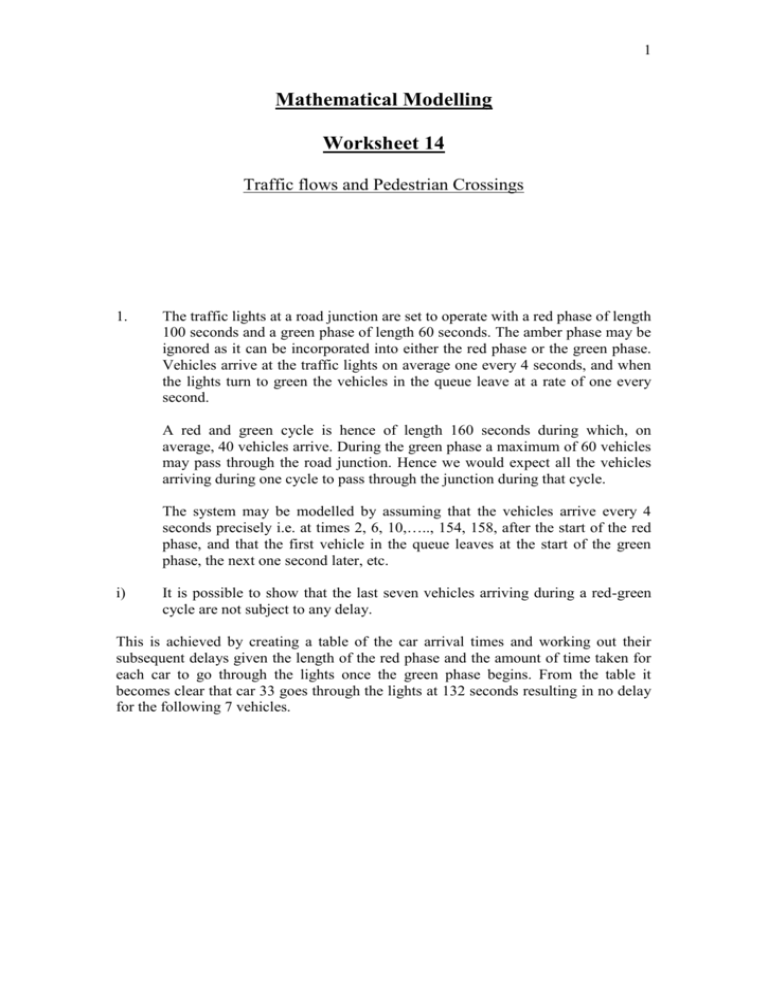
1 Mathematical Modelling Worksheet 14 Traffic flows and Pedestrian Crossings 1. The traffic lights at a road junction are set to operate with a red phase of length 100 seconds and a green phase of length 60 seconds. The amber phase may be ignored as it can be incorporated into either the red phase or the green phase. Vehicles arrive at the traffic lights on average one every 4 seconds, and when the lights turn to green the vehicles in the queue leave at a rate of one every second. A red and green cycle is hence of length 160 seconds during which, on average, 40 vehicles arrive. During the green phase a maximum of 60 vehicles may pass through the road junction. Hence we would expect all the vehicles arriving during one cycle to pass through the junction during that cycle. The system may be modelled by assuming that the vehicles arrive every 4 seconds precisely i.e. at times 2, 6, 10,….., 154, 158, after the start of the red phase, and that the first vehicle in the queue leaves at the start of the green phase, the next one second later, etc. i) It is possible to show that the last seven vehicles arriving during a red-green cycle are not subject to any delay. This is achieved by creating a table of the car arrival times and working out their subsequent delays given the length of the red phase and the amount of time taken for each car to go through the lights once the green phase begins. From the table it becomes clear that car 33 goes through the lights at 132 seconds resulting in no delay for the following 7 vehicles. 2 Car arrival times secs (s) 2 6 10 14 18 22 26 30 34 38 42 46 50 54 58 62 66 70 74 78 82 86 90 94 98 102 106 110 114 118 122 126 130 134 138 142 146 150 154 158 Delay (s) 98 95 92 89 86 83 80 77 74 71 68 65 62 59 56 53 50 47 44 41 38 35 32 29 26 23 20 17 14 11 8 5 2 0 0 0 0 0 0 0 Red Phase Green Phase Car 33 goes through the lights at 132 seconds resulting in no delay for the following 7 vehicles Red Phase 3 ii) From the table it is possible to find the average delay per vehicle. Average Delay per vehicle = 2. 1 1650 Delay (s) 41.25 seconds. 40 40 We can consider the traffic light model of question (1) with general values of the parameters: rv = length of red phase (seconds). g v = length of green phase (seconds). a = time between arrivals of vehicles (seconds). d = time between departure of vehicles in the queue (seconds). i) It is possible to devise a formula to give the average delay per vehicle in terms of rv , g v , a and d. Average Delay per vehicle = N = number of vehicles = The 1 N Delay rv g v a Delay can be expressed as the sum of an arithmetic progression: Sn where 1 n A L 2 A = first term = a - d L = last term = rv - 1 n= rv 1 ad rv 1 a d r 1 v 2a d r 1 1 rv 1 v 2 a d Sn Average Delay per vehicle = arv 1 rv 1 1 2rv g v a d 4 ii) If the system is modelled stochastically rather than deterministically, what effect will this have on the average delay per vehicle? In this case the car arrival and departure times are random variables. X = arrival time. Y = departure time. X ~ P0 a Y ~ P0 d Therefore taking into consideration random variation, if a large number of vehicles arrive at the traffic lights in a short period of time then the average delay per vehicle will increase due to the congestion. However if very few cars arrive at the lights over a short period of time then the average delay per vehicle will decrease because there is no long standing cue of traffic waiting to go through. 3. The flow of pedestrians at a road crossing is controlled by a set of traffic lights that operate on a fixed cycle basis. The red light is shown to pedestrians for rp seconds, the green light for g p seconds. We can assume that pedestrians arrive at the rate of one person every b seconds, and that all pedestrians arriving during the red phase cross the road at the start of the green phase, and those pedestrians arriving during the green phase cross the road immediately. From this information we can find a formula for the average delay per pedestrian. The formula can be obtained by using a similar method to that used in question (2): Average Delay per pedestrian = N = number of pedestrians = The 1 N Delay rp g p b Delay can be expressed as the sum of an arithmetic progression: Sn 1 n A L 2 In this case d will be zero because there is no time between the crossing of pedestrians. 5 so A = first term = b L = last term = rp n= Sn rp rp b b rp 2b rp rp 1 2 b Average Delay per pedestrian = 4. rp 1 2rp g p b brp Pedestrians cross a one-way street at a point P where there are no traffic lights or other traffic controls. It takes a pedestrian f seconds to cross the road, and vehicles pass at random such that there is an average of a seconds between the times when successive vehicles pass point P. i.e. the number of vehicles that pass point P in one second is a Poisson random 1 variable with mean . a i) It is possible to demonstrate that a deterministic model in which vehicles are assumed to pass point P at exact intervals of a seconds is inappropriate for determining the average delay to pedestrians. Pedestrians can cross if and only if the times between successive vehicles passing point P is greater than the time it takes to cross the road. P a>f f secs Car 6 Therefore the deterministic model is inappropriate for determining the delay to pedestrians because the cars arrive at regular intervals. In reality if a<f then the pedestrians would never cross the road, which is not a realistic model. ii) We can use a stochastic model to determine the average delay to pedestrians in terms of f and a. The car interval is a random variable. 1 X ~ P0 a N Waiting time 1 W ~ Ex a P X f f 0 f 0 f 1 at e dt 1 e a a P 1 at e dt mean of exponential distribution over f. a a a f e f a A mean waiting time of 1 vehicle. AP is the average time one has to wait for 1 car. AP 2 is the average time one has to wait for 2 cars. AP 3 is the average time one has to wait for 3 cars. . . . n AP is the average time one has to wait for n cars. This gives AP AP 2 AP 3 ..... AP n A P P 2 P 3 ..... P n This can be written as the sum of a geometric series. 7 That is P 1 P Therefore the average waiting time for any one person is = This equation can be re-written in terms of f and a. f f a a a a f e 1 e AP f 1 P 1 1 e a a a f e f a ae e f ae a a f e f a f a a f e f a f 2a 2f a AP 1 P
